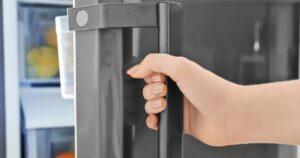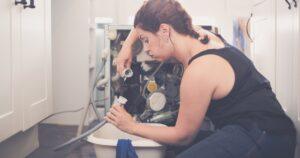Why is Your Fridge Leaking Water? Almost every homeowner dreads discovering water inside or under their fridge. There could be several reasons for this, including a blocked defrost drain, defective defrost drain pan, issues with the ice maker or water dispenser, or problems like a broken drain pan, food stored incorrectly, too much freezer defrosting, a faulty door seal, or a clogged drain hole.
How do you know that your fridge is leaking?
There are several signs that can indicate your fridge may be leaking water. One of the most obvious is finding water pooled on the floor underneath the fridge. You can also check for water or moisture buildup around the fridge seals or on the bottom interior of the fridge compartment.
Another sign is ice developing inside the fridge spaces that shouldn’t be freezing. If you notice a damp smell coming from the fridge, it could result from excess water accumulation from an internal leak. Regularly checking these areas can help detect any leaks early before they worsen. Paying attention to such signs can help determine if a leak requires repair.

What to check for a leaking fridge?
When a fridge is found to be leaking water internally, it’s important to carefully inspect key components and areas that could be contributing to the issue. Identifying the source of excess water is the first step in the repair process. Some common factors include the defrost drain, drain pan and ice maker systems.
By thoroughly checking these potential trouble spots, homeowners can pinpoint where drainage or collection may be failing inside their appliances. An inspection of the following will help determine what needs fixing to stop their fridge from leaking:
Blocked Defrost Drain:
If you’ve determined your fridge is leaking water, one of the first things to check is the defrost drain. As mentioned, a blocked drain can cause water to accumulate inside instead of draining properly. To inspect it, locate the drain hole usually found in the bottom or back panel of the refrigerator compartment. Carefully remove any debris or buildup trapped inside the hole using a bottlebrush or compressed air. Make sure water flows freely through the drain when blowing into it. Clearing a clogged drain is sometimes all that’s needed to resolve minor water leaks.
Defrost Drain Pan:
You should also examine the defrost drain pan, which is a tray located above or below the drain hole to catch and direct melting ice and moisture during automatic defrost cycles. Look for any cracks or damaged areas that may prevent the pan from fully redirecting water down the drain. Over time, pans can corrode or develop small fractures that allow water to escape around the edges. Replacing a cracked or outdated pan can be a straightforward repair for persistent leaking issues.
The Ice Maker and Water Dispenser:
If your fridge includes an automatic ice maker or dispenser, also inspect these systems carefully for potential leaks. Check the O-rings and gaskets on the ice maker assembly and water supply lines for cracks, breaks, or gaps that may be causing water to spill internally. The ice maker fill tube can develop kinks or weak spots over time as well. Replacing worn parts is usually a simple DIY repair if a built-in ice maker or dispenser is the root of water leaks inside the fridge space.
Common Reasons why the fridge is leaking water inside?
There are often underlying causes behind why excess water may accumulate inside a fridge and lead to leakage issues. Some of the most prevalent reasons homeowners discover include problems with the draining system, improper food storage practices, excessive defrosting, and faulty components affecting temperature and sealing. A closer look at the following potential factors can help determine the root problem:
Broken drain pan:
Over time, the constant freezing and thawing process during automatic defrost cycles places stress on the metal material of the drain pan. This repetitive exposure can cause tiny cracks or fractures to develop that aren’t always visible to the naked eye. As water collects in the pan, these flaws allow it to slowly leak out before reaching the drain hole. Even a minuscule leak multiplied daily eventually leads to a water mess inside the fridge.
Food not stored correctly:
Perforated shelves and vents in the fridge walls regulate temperature and humidity levels by promoting airflow. However, if food is crowded too tightly or sealed flush to shelves, it blocks these openings from performing properly. Trapped air becomes saturated more rapidly, resulting in excess condensation that pools on surfaces there’s no place else to go. Rotting food or stains can then signal the start of a leaking problem.
Too much freezer defrosting:
During manual defrosts, the freezer compartment converts from sub-freezing to above-freezing temperatures. While this process assists ice melt, doing it too often stresses the drainage system. A high-capacity drain can handle some excess water, but multiple extra-long defrost periods introduce more melted fluid than was designed for. Overburdened drainage paths overflow, leading water to leak into unintended areas.
Faulty door seal:
Rubber seals around the fridge door edges deteriorate naturally with continuous use and cleaning. As seals degrade, they fail to form an airtight barrier when closed. Without a proper compression fit, cooled air slips out raising energy bills. Simultaneously, increased ventilation allows more humidity into the fridge than the system can remove through dehumidifying processes alone.
Clogged drain hole:
Food crumbs or built-up mineral deposits can slowly block the narrow drain opening over time. Unable to flow, all collected water backs up with no escape. Bottlenecks lead to overflow situations until they find weak points to breach containment through unintended leakage.
Defective temperature control:
Issues with the thermostat, fan, cooling nozzle or other refrigeration components disrupt the delicate temperature/humidity balance. Improper functioning risks condensation levels exceeding the system’s capacity for moisture control. Pressure builds steadily until water is forced out of infiltration points.
How to Fix a Fridge Leak Water?
For leaks stemming from internal component failures, homeowners may need to perform slightly more complex repairs. Replacing the entire water supply line is one such job that requires carefully disconnecting pipes behind the fridge. Start by locating supply line attachment points and shutoff valves. Use adjustable wrenches to detach old supply tubing at compatible fittings.
Slice through any hardened connections with a utility knife as needed. Thoroughly clean away residue before fastening new inspection-friendly lines using thread tape or plumber’s putty. Test for leaks by pressing line joints before turning the water source back on. Proper installation ensures a lasting solution for water supply-caused appliance leakage issues.
Why choose Ash Appliance Repair for Fridge Repair in Vancouver?
Whether facing a minor fridge water leak or more complex repair needs, homeowners in Vancouver trust Ash Appliance Refrigerator Repair for our specialized services. As the area’s leading experts, we have over 15 years of experience fixing all appliance brands and issues. Our NATE-certified team closely examines each job to thoroughly diagnose root causes. From unclogging drains to full part replacements, we have the skills and Original Equipment Manufacturer (OEM) components to restore healthy operation.
Our licensed technicians are fully background-checked for customers’ peace of mind too. Plus, we offer affordable flat rates upfront and a 90-day warranty on all workmanship. Choosing Ash ensures timely repairs are done right the first time so homeowners’ fridge safely stops leaking without future frustrations.






